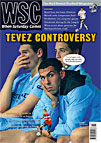 An unlikely agreement in South Yorkshire may benefit both Sheffield clubs, reports Tom Hocking
An unlikely agreement in South Yorkshire may benefit both Sheffield clubs, reports Tom Hocking
As the Sheffield United and Sheffield Wednesday players run out at Bramall Lane this month the rivalry in the stands will be as volatile as ever. United’s directors and executives, however, will be welcoming some familiar faces from across the city, having spent their summers locked in negotiations.
With both clubs needing new sponsors for 2011-12, a lack of interest from national firms meant looking local. No company wanted to sponsor one half of the city for fear it would alienate the other. Nor would they pay the full cost of sponsoring both teams, like in Glasgow. The clubs entered negotiations with two local firms: VW Gilder Group and Westfield Health. It resulted in Wednesday having Gilder on their home shirt and Westfield on their away, while United’s arrangement would be the opposite. It’s unique in English football. After the “we got more money than you” posturing from fans subsided (the financial details are yet to be released), it was widely agreed that the clubs had made the best of a bad situation. It begs the question of how much further can their collaboration be taken and why more rivals don’t work together.
The idea of a merger or groundshare was crushed by opposition in the 1990s – it was agreed that it would be unacceptable for Sheffield to lose one of its clubs or historic stadiums. Prior to this season, Dr Simon Chadwick, professor of sport business strategy at Coventry University, suggested: “The most realistic option would be to pool resources in other way… I’m sure Sheffield Wednesday have a marketing team, and so do Sheffield United. It may be that you could have one team representing both clubs so they co-market each other.”
That showed a lack of understanding, however. Wednesday promoting United’s products is akin to Tesco suggesting you try Asda next week because they have a good offer on ice cream.
There’s potential for rivals to work together more effectively, though. This summer Aston Villa, Birmingham City, Wolverhampton Wanderers, Coventry City, Walsall and Derby County promoted grassroots football across the Midlands at the BRMB Grass Roots Football Show. All the clubs have their own projects but it was the first time they had come together under one banner. The event signalled an understanding that promoting such a grassroots initiative as a collective could do more good than individual campaigns.
It would seem sensible for the Sheffield clubs to put egos and competitive scouting aside by teaming up with the likes of Doncaster Rovers, Barnsley and Rotherham United to promote football in the region. Maintaining or reigniting people’s interest in the sport at the most basic level is an initiative that can only benefit every club.
When it comes to selling merchandise in drab economic times, both United and Wednesday have goods scattered across the city centre in small sections of department stores. Bramall Lane is walking distance from town but Hillsborough is a fair tram ride away and their previous (small) city centre shop closed down years ago. Sheffield’s sport is invisible to its customers. While rent would be too high for one club to manage, if football combined with ice hockey (the Steelers are the best-supported ice hockey team in the country) as well as rugby (Eagles) and even basketball (Sharks), then opportunities arise to put the city’s sporting pedigree in the forefront of their potential customers’ minds. The advantage is that each individual club would not have to foot the full bill.
The potential isn’t restricted to South Yorkshire. Cities such as Bristol, Nottingham, Dundee and Edinburgh could find their clubs benefiting from collaboration rather than confrontation in commercial areas. Even on Merseyside some feel that the two teams should work together and, whisper it, share a ground. With Liverpool having run out of space and Everton’s finances a shambles, co-operation may yet be the best solution.
As Wednesday and United battle it out at Bramall Lane, the sponsors and executives will look on, knowing they struck a deal that benefited all concerned without damaging the integrity or identity of either club. It’s a model that others may replicate in coming seasons.
From WSC 297 November 2011